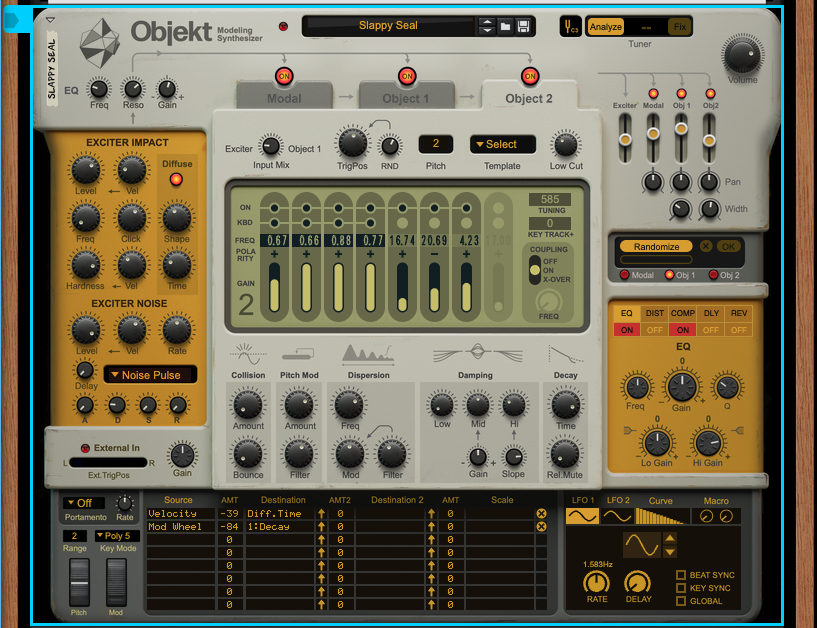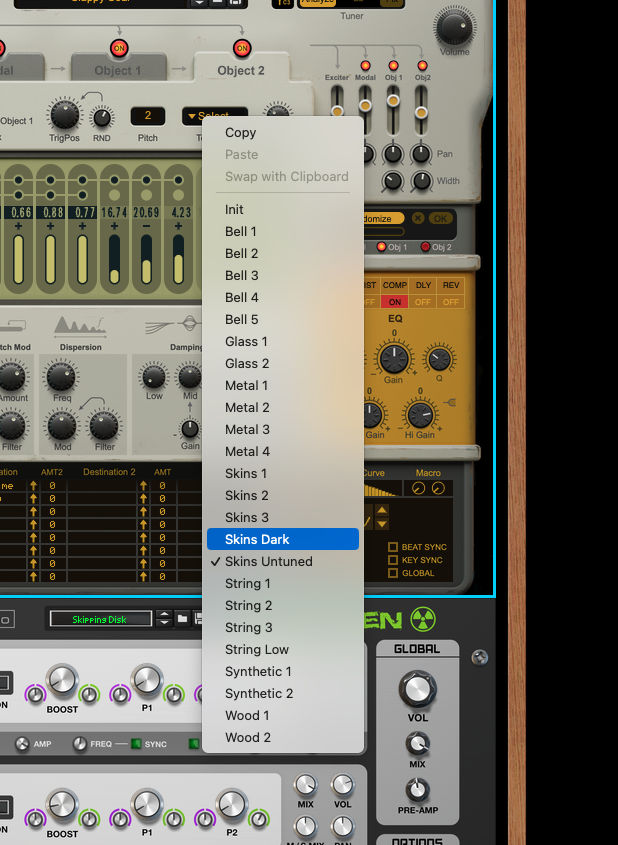It’s not every day we get a new, full-featured physical modeling synth. So welcome to Objekt, a new Reason Rack Extension – and possibly the most notable instrumental addition to Reason in years.
Physical modeling is uniquely organic and expressive among synthesis approaches. But that’s not to say there are a whole lot of instruments based on the approach, compared to, say, subtractive synthesis. Maybe it’s because it can also be a challenge to tune and voice – anything involving a resonator is also prone to feedback and just general weirdness. Or maybe it’s because physical modeling doesn’t fit into the retro appetites of the synth market – there’s not a definitive use of the technique or a song to point to. (Sure enough, a lot of what you do get will be just a piano or just some other acoustic instrument.)
For me, the main reference points at the moment are Applied Acoustics’ Chromaphone and modular Multiphonics CV-2, and while it’s long in the tooth, Apple’s Sculpture. For string-specific modeling, Reason’s own Friktion is exceptional.
Objekt for me immediately stands with those, with some sonic capabilities and an approach to sound programming that are unlike what you’ll find elsewhere. It’s reason enough to open Reason or the Reason Rack plug-in. (Reason Studios did not build a separate plug-in version.)
There’s just so much here. And it’s truly open-ended physical modeling – you’re incredibly free to mess with every parameter at will. Starting sounds from scratch is satisfying. It’s a huge feat of design. Physical models are usually either unwieldy or have lots of guardrails on. Objekt by contrast is an open sandbox, but one where you never feel lost.
There’s a great tutorial on physical modeling inside Objekt from Reason Studios, worth watching even just if you’re curious about this approach to sound:
Understanding the interface and sound structure
The core of Objekt, as the name hints, is three resonating objects.
The first, Modal, is a set of tuned resonating filters, plus pickup control (with drive and symmetry) and decay. That is, it’s a modal synthesizer voice – capable of producing pure, short, percussive sounds.
Then, you have two Objects (Object 1 and Object 2) based on resonant delay feedback. (If you’ve ever messed with Karplus-Strong physical modeling, the simplest version of this – same fundamental idea.) These add additional controls for collision, pitch mod, dispersion, damping, and decay among others.

What’s essential in this section is that everything can be enabled/disabled and tuned. They’re not kidding when they say open-ended. Enable and disable objects and frequency bands. Set each frequency band to whatever you want.
To keep from winding up at sea setting frequencies for each band, pull up the template menu for pre-configured options for bells, wood, skins, strings, and whatnot. But you’re not limited to those, either – if you want to look up some bell from a specific temple bell and enter measurements of its resonating frequencies, you can.

This is really far beyond what you’ll find in other physical modeling synths. In Chromaphone, for instance, you can set custom resonator frequencies (by setting a resonator type to manual), but you’re limited to four fixed bands for each resonator.
There’s also a detailed Exciter Impact section for exciting your objects – as you would do to model mallets, string plucks, bows, and whatnot. There are some really nice controls to check here, too, which add an uncommon amount of detail to those sounds – a click control, a shaper, and lots of noise color types go beyond the usual hardness, frequency, and envelope controls.
Plus there’s a complete Modulation Matrix. In combination with Reason’s usual Rack patching powers, this can get really deep, and lets you treat Objekt as a creative synth – making unrealistic and inventive twists and turns in your sound, not just buttoned-up acoustic models. Reason Studios have as usual crammed a lot of stuff into the UI, so note that you could easily miss that the macro controls are tucked into the modulation section.
Getting into some real overkill, there’s also a multi-effects section, on top of whatever you want to patch into with your Rack. That includes EQ, distortion, compressor, delay, and reverb – each of those with multiple models.
Here’s just a quick demo of me messing around. By the way, Mutagen you won’t find in Rack Extensions; the company is out of business. But I literally today updated it to Apple Silicon code. That’s what future-proofing means in Rack Extensions format, and apart from open source code, there’s really nothing else like it.
And yes, this also shows that the generative devices BeatMap and Bassline Generator are great for creating unexpected inspiration.
What it means to be open-ended
The team behind Objekt has really gone to great lengths to make a sound designer’s physical modeling instrument. Both Sculpture and the OBJEQ filter that’s at the heart of AAS’ instruments are built around imagining the resonator in terms of a physical object. So too some of their exciter descriptors (true as well in AAS’ physical modeling work for Ableton). That’s present in Objekt’s templates, but everywhere else in the interface, you’re really just working with exciter and frequencies directly without any instrumental reference.
You’re really free from the start to build sounds in Objekt from the ground up, and layer exciter and resonant objects absolutely from scratch, tuning each frequency. That’s a radical approach, and yet – here’s the surprise – it’s frankly easier to program Objekt than it is some of its rivals.
Reason Studios has just absolutely nailed it as far as interface layout. There’s some logic (sorry) to the structure, signal flow, and parameters of Objekt that let you get your hands dirty in every detail intuitively.
They’ve also done a great job with presets – because everything is modifiable, you can pull up some instrument as a starting point and then immediately warp it to something subtly or wildly different.
Some other quick notes:
- The Rack side of things allows two CV inputs, two CV outputs for patching.
- You can use external audio signal as an exciter, turning this into an object filter.
- There’s a convenient randomize control with amount for experimenting with variation.
- You can mess with legato and create some really wild physical modeled glide.
There’s not tuning support for tunings tables like Scala, which I’m a bit sad to see – maybe someone else has a solution via Rack Extensions? That said, you can manually tune it like an acoustic instrument – and there’s a built-in tuner for reference.
But yeah – put all of this together, and you get something more than the sum of its parts. Objekt is capable of extraordinary, organic sounds that transcend any particular genre. You can make kick drums and percussion. You can build bass lines that sound like nothing else. You can create realistic acoustic-sounding instruments, or something alien, or something in between.
The quality of the patch library really helps for a leg-up there, too; it makes a big difference.
Objekt is capable of extraordinary, organic sounds that transcend any particular genre.
Objekt permanance
Objekt for me at least immediately finds a clear niche, even having played with stuff in Pd, Reaktor, SuperCollider, and whatnot. The combination of clear access to modal synthesis with musical controls for exciter and timbre, easy mixing of the objects and exciter, and modulation is an instant-win. It’s even making Reason Rack show up in my sessions in other DAWs again.
It’s worth revisiting the other physical modeling options. Chromaphone is still easy to recommend – multi-timbral, Scala tuning support, tons of beautiful presets, and its own unique combination of exciter / object / filter / effects. I get bored with multiple subtractive synths, but I don’t get bored of physical modeling plug-ins; it’s interesting how you can be led in some different directions with these different designs.
It’s one of the greatest triumphs of Reason’s instrument design since the likes of Malström.
Sculpture remains weird as ever, and we’ll see if Apple will port this to iPadOS or update its desktop UI. It’s a fair comparison to Objekt, though – it also has a structure of three resonant objects, a lot of modulation, and exciter details plus waveshaper. Of course, from there, almost everything is different, assuming you can get as far as squinting at the bizarre UI. Exciter types are on the object. There’s that unique graphical pickup interface (which is also very quickly capable of completely feeding back). And there’s the crazy morphing interface, though that reminds me – I should totally try automating modulation by patching in another device in the Rack, which isn’t as easy in Logic. Sculpture for its part has its own depth and – if you want a 5.1 surround instrument, it’s definitely your choice.
Friktion is better focused on string modeling if that’s your aim, though Objekt is more general purpose and easily morphs between things that sound string-like, percussion-like, wind-like, and other blurred categories without any clear boundaries.
Any physical modeling fan should take a second look at the Reason value proposition given the existence of Objekt – that Reason+ subscription looks appealing even if you mainly stick to other DAWs for arrangement. And if you’re a Reason user – Objekt is a must. It’s one of the greatest triumphs of their instrument design since the likes of Malström. And I can’t wait to overuse it.
https://reasonstudios.com/products/objekt/
